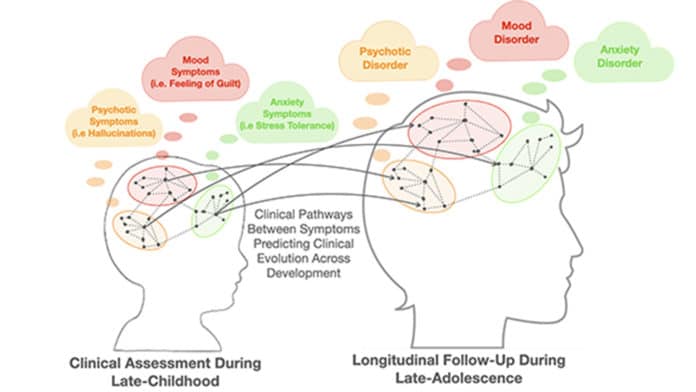In collaboration with a team from EPFL, a team from the University of Geneva (UNIGE) has used a longitudinal manner an artificial intelligence tool to determine symptoms of a psychotic illness in the child’s future developmental trajectory. This is the first time that the method of longitudinal network analysis has been applied to children to detect the symptoms that herald the development of psychotic illness.
Over twenty years, this algorithm correlates many variables from different backgrounds – neurobiological, psychological, cognitive, etc.
One-third of children with a microdeletion of chromosome 22 will later develop a psychotic illness such as schizophrenia. One in 4,000 people have Chromosome 22 Deletion that later leads to the development of psychotic illness. However, only one-third of them will eventually be affected by a psychotic disorder.
How can we determine which ones?
Corrado Sandini, a researcher at the Department of Psychiatry of UNIGE Faculty of Medicine, said, “For the time being, the analyses are looking at the neurobiological mechanisms involved in psychological disorders, as well as the presence of certain symptoms that are assimilated to a psychological illness, without knowing which are the most relevant.”
“This is why we thought of using the network analysis method. This methodology, which is currently used on adults, makes it possible to combine variables from completely different worlds in the same analysis space while considering them individually.”
Stéphan Eliez, professor in the Department of Psychiatry at the UNIGE Faculty of Medicine and to the Foundation Pôle Autisme, said, “Since the development of psychotic illnesses depends on many variables other than purely neurobiological ones, this algorithm would make it possible to highlight the most important symptoms to alert about the potential risks of a child becoming schizophrenic, for example.”
Scientists applied their method to a cohort of children and adolescents suffering from a chromosome 22 deletion. They want to obtain insightful statistics on highly intertwined variables throughout the child’s developmental trajectory.
Dimitri Van De Ville, a professor in the Department of Radiology and Medical Informatics at UNIGE Faculty of Medicine and the EPFL Institute of Bioengineering, said, “The aim is to find the variables in childhood that will foresay the development of psychotic illnesses. We will therefore know which battle to fight, thanks to key factors that will enable us to act where and, above all, when it is necessary.”
“If we can identify them, we can try to regulate the symptom to reduce the risk of developing a psychotic illness later on.”
Scientists tested their methodology by considering 40 variables for 70 children suffering from a microdeletion of chromosome 22. The Children were observed every three years from childhood to adulthood.
The variables include hallucinations, general mood, feelings of guilt, and the management of daily stress.
Sandini said, “Questionnaires completed by parents also provided valuable data. Visual representations then shed light/highlighted/determined the most important variables that predict the development of psychological problems three years later.”
“We found that an anxious 10-year-old whose anxiety turns into an inability to cope with stress in adolescence is likely to develop a psychological illness. The evolution of anxiety is, therefore, a significant warning signal. Similarly, sadness, which over time becomes a feeling of guilt, is also a significant symptom.”
The results of the algorithm were confirmed by applying it to other cohorts vulnerable to psychotic illnesses. Scientists now want to use it as a predictive tool.
Journal Reference:
- Corrado Sandini, Daniela Zöller et al. Characterization, and prediction of clinical pathways of vulnerability to psychosis through graph signal processing. DOI: 10.7554/eLife.59811
